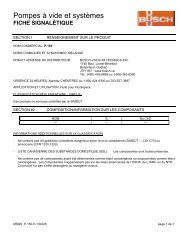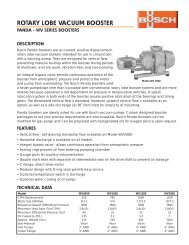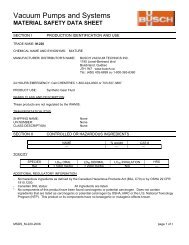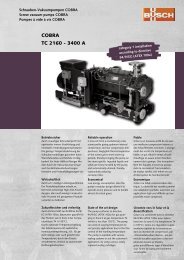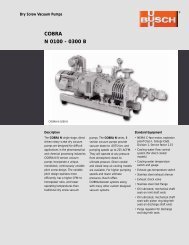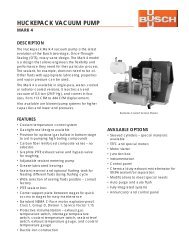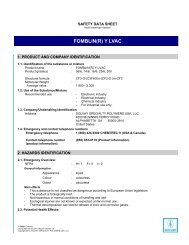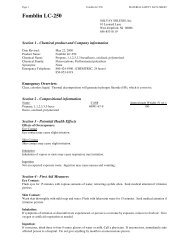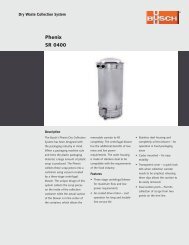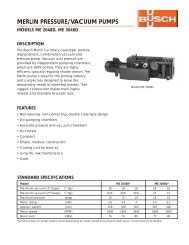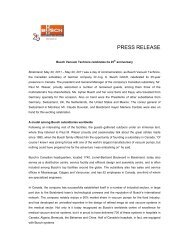Material Safety Data Sheet - Busch Vacuum Technics
Material Safety Data Sheet - Busch Vacuum Technics
Material Safety Data Sheet - Busch Vacuum Technics
Create successful ePaper yourself
Turn your PDF publications into a flip-book with our unique Google optimized e-Paper software.
R-530S Page Number: 24 .Eye contactSkin contactInhalationIngestionFirst-aid measuresProtection of first-aidersNotes to physician5 .Fire-fighting measuresFlammability of the product :Extinguishing mediaSuitable :Not suitable :Special exposure hazards :Products of combustionSpecial protectiveequipment for fire-fightersSpecial remarks on firehazardsSpecial remarks onexplosion hazards6 .:::::Check for and remove any contact lenses. Immediately flush eyes with plenty of waterfor at least 15 minutes, occasionally lifting the upper and lower eyelids. Get medicalattention immediately.In case of contact, immediately flush skin with plenty of water for at least 15 minuteswhile removing contaminated clothing and shoes. Wash skin thoroughly with soap andwater or use recognised skin cleanser. Wash clothing before reuse. Clean shoesthoroughly before reuse. Get medical attention immediately.Move exposed person to fresh air. If not breathing, if breathing is irregular or ifrespiratory arrest occurs, provide artificial respiration or oxygen by trained personnel.Loosen tight clothing such as a collar, tie, belt or waistband. Get medical attentionimmediately.Wash out mouth with water. Do not induce vomiting unless directed to do so by medicalpersonnel. Never give anything by mouth to an unconscious person. Get medicalattention immediately.: No action shall be taken involving any personal risk or without suitable training. It maybe dangerous to the person providing aid to give mouth-to-mouth resuscitation.:::No specific treatment. Treat symptomatically. Contact poison treatment specialistimmediately if large quantities have been ingested or inhaled.May be combustible at high temperature.Use an extinguishing agent suitable for the surrounding fire.None known.Accidental release measuresPersonal precautions :Environmental precautionsMethods for cleaning upSmall spill :Promptly isolate the scene by removing all persons from the vicinity of the incident ifthere is a fire. No action shall be taken involving any personal risk or without suitabletraining.: Carbon oxides (CO, CO2), nitrogen oxides (NOx), sulphur oxides (SOx), hydrocarbons,smoke and irritating vapours as products of incomplete combustion.Fire-fighters should wear appropriate protective equipment and self-contained breathingapparatus (SCBA) with a full face-piece operated in positive pressure mode.Low fire hazard. This material must be heated before ignition will occur.Do not pressurise, cut, weld, braze, solder, drill, grind or expose containers to heat orsources of ignition.No action shall be taken involving any personal risk or without suitable training.Evacuate surrounding areas. Keep unnecessary and unprotected personnel fromentering. Do not touch or walk through spilt material. Avoid breathing vapour or mist.Provide adequate ventilation. Wear appropriate respirator when ventilation isinadequate. Put on appropriate personal protective equipment (see section 8).: Avoid dispersal of spilt material and runoff and contact with soil, waterways, drains andsewers. Inform the relevant authorities if the product has caused environmental pollution(sewers, waterways, soil or air).Stop leak if without risk. Move containers from spill area. Dilute with water and mop upif water-soluble or absorb with an inert dry material and place in an appropriate wastedisposal container. Dispose of via a licensed waste disposal contractor.Date of issue : 10/23/2009. Internet: busch.ca Page: 2/6
R-530S Page Number: 36 .Accidental release measuresLarge spill :Stop leak if without risk. Move containers from spill area. Approach the release fromupwind. Prevent entry into sewers, water courses, basements or confined areas. Washspillages into an effluent treatment plant or proceed as follows. Contain and collectspillage with non-combustible, absorbent material e.g. sand, earth, vermiculite ordiatomaceous earth and place in container for disposal according to local regulations(see section 13). Dispose of via a licensed waste disposal contractor. Contaminatedabsorbent material may pose the same hazard as the spilt product. Note: see section 1for emergency contact information and section 13 for waste disposal.7 .Handling and storageHandlingStorage::Put on appropriate personal protective equipment (see section 8). Eating, drinking andsmoking should be prohibited in areas where this material is handled, stored andprocessed. Workers should wash hands and face before eating, drinking and smoking.Do not ingest. Avoid contact with eyes, skin and clothing. Avoid breathing vapour ormist. Keep in the original container or an approved alternative made from a compatiblematerial, kept tightly closed when not in use. Empty containers retain product residueand can be hazardous. Do not reuse container.Store in accordance with local regulations. Store in original container protected fromdirect sunlight in a dry, cool and well-ventilated area, away from incompatible materials(see section 10) and food and drink. Keep container tightly closed and sealed untilready for use. Containers that have been opened must be carefully resealed and keptupright to prevent leakage. Do not store in unlabelled containers. Use appropriatecontainment to avoid environmental contamination.8 .Exposure controls/personal protectionIngredientMixture of severely hydrotreated andhydrocracked base oil (petroleum).Exposure limitsACGIH TLV (United States). Notes: (oil mist)TWA: 5 mg/m³ 8 hour(s).STEL: 10 mg/m³ 15 minute(s).Consult local authorities for acceptable exposure limits.Recommended monitoringproceduresEngineering measuresHygiene measuresPersonal protectionRespiratoryHands :Eyes: If this product contains ingredients with exposure limits, personal, workplace atmosphereor biological monitoring may be required to determine the effectiveness of the ventilationor other control measures and/or the necessity to use respiratory protective equipment.: No special ventilation requirements. Good general ventilation should be sufficient tocontrol worker exposure to airborne contaminants. If this product contains ingredientswith exposure limits, use process enclosures, local exhaust ventilation or otherengineering controls to keep worker exposure below any recommended or statutorylimits.: Wash hands, forearms and face thoroughly after handling chemical products, beforeeating, smoking and using the lavatory and at the end of the working period. Appropriatetechniques should be used to remove potentially contaminated clothing. Washcontaminated clothing before reusing. Ensure that eyewash stations and safety showersare close to the workstation location.::Use a properly fitted, air-purifying or air-fed respirator complying with an approvedstandard if a risk assessment indicates this is necessary. Respirator selection must bebased on known or anticipated exposure levels, the hazards of the product and the safeworking limits of the selected respirator. Recommended: organic vapour filterChemical-resistant, impervious gloves complying with an approved standard should beworn at all times when handling chemical products if a risk assessment indicates this isnecessary.Recommended: neoprene, nitrile, polyvinyl alcohol (PVA), Viton.<strong>Safety</strong> eyewear complying with an approved standard should be used when a riskassessment indicates this is necessary to avoid exposure to liquid splashes, mists ordusts.Date of issue : 10/23/2009. Internet: busch.ca Page: 3/6
R-530S Page Number: 48 .Exposure controls/personal protectionSkin :Environmental exposurecontrols9 .Physical stateFlash pointPersonal protective equipment for the body should be selected based on the task beingperformed and the risks involved and should be approved by a specialist before handlingthis product.: Emissions from ventilation or work process equipment should be checked to ensure theycomply with the requirements of environmental protection legislation. In some cases,fume scrubbers, filters or engineering modifications to the process equipment will benecessary to reduce emissions to acceptable levels.Physical and chemical propertiesAuto-ignition temperatureFlammable limitsColourOdourOdour thresholdpHBoiling/condensation pointMelting/freezing pointRelative densityVapour pressureVapour densityVolatilityEvaporation rateViscosity:Viscous liquid.: Open cup: >220°C (428°F) [Cleveland.]:::::::::::::Not available.: Not available.Pale yellow to crystal clear.Slight petroleum oil like.Not available.Not available.Not available.Not available.0.861 to 0.8682 kg/L @ 15°C (59°F)Not available.Not available.Not available.Not available.103.1 cSt @ 40°C (104°F), 11.4 cSt @ 100°C (212°F), VI=97;Pour pointSolubility10 .: -12°C (10°F):Insoluble in water.Stability and reactivityChemical stabilityHazardous polymerisation<strong>Material</strong>s to avoidHazardous decompositionproducts11 .::::The product is stable.Toxicological informationUnder normal conditions of storage and use, hazardous polymerisation will not occur.Reactive with oxidising agents, reducing agents, acids and alkalis.May release COx, diphenylamine, smoke and irritating vapours when heated todecomposition.Acute toxicityProduct/ingredient name Result Species Dose ExposureMixture of severely hydrotreated and LD50 Dermal Rabbit >2000 mg/kg -hydrocracked base oil (petroleum).LD50 Oral Rat >5000 mg/kg -LC50 InhalationDusts and mistsRat >2500 mg/m³ 4 hoursConclusion/SummaryChronic toxicityConclusion/SummaryIrritation/Corrosion: Not available.: Not available.Date of issue : 10/23/2009. Internet: busch.ca Page: 4/6
R-530S Page Number: 511 .Toxicological informationConclusion/SummarySensitiserConclusion/SummaryCarcinogenicityConclusion/SummaryMutagenicityConclusion/SummaryTeratogenicityConclusion/SummaryReproductive toxicityConclusion/Summary12 .: Not available.: Not available.: Not available.: Not available.: Not available.: Not available.Ecological informationEnvironmental effectsAquatic ecotoxicityConclusion/SummaryBiodegradabilityConclusion/SummaryOther adverse effects13 .Waste disposal: No known significant effects or critical hazards.: Not available.: Not available.Disposal considerations: No known significant effects or critical hazards.:The generation of waste should be avoided or minimised wherever possible. Emptycontainers or liners may retain some product residues. This material and its containermust be disposed of in a safe way. Dispose of surplus and non-recyclable products viaa licensed waste disposal contractor. Disposal of this product, solutions and any byproductsshould at all times comply with the requirements of environmental protectionand waste disposal legislation and any regional local authority requirements. Avoiddispersal of spilt material and runoff and contact with soil, waterways, drains and sewers.Disposal should be in accordance with applicable regional, national and local laws and regulations.Refer to Section 7: HANDLING AND STORAGE and Section 8: EXPOSURE CONTROLS/PERSONAL PROTECTIONfor additional handling information and protection of employees.14 .RegulatoryinformationTransport informationTDG Classification Not- --regulated.DOT ClassificationPG* : Packing group15 .United StatesHCS ClassificationCanadaUN numberNot available.Proper shippingnameRegulatory informationWHMIS (Canada)::Classes PG* Label AdditionalinformationNot available. Not available. --Not regulated.Not controlled under WHMIS (Canada).This product has been classified in accordance with the hazard criteria of the Controlled Products Regulations andthe MSDS contains all the information required by the Controlled Products Regulations.-Date of issue : 10/23/2009. Internet: busch.ca Page: 5/6
R-530S Page Number: 615 . Regulatory informationEU regulationsRisk phrases: This product is not classified according to EU legislation.International regulationsCanada inventoryUnited States inventory(TSCA 8b)Europe inventory: All components are listed or exempted.: All components are listed or exempted.: All components are listed or exempted.16 .Other informationHazardous <strong>Material</strong>Information System (U.S.A.):HealthFlammability11Physical hazards0Personal protectionBNational Fire ProtectionAssociation (U.S.A.):Health110FlammabilityInstabilitySpecialReferences:Available upon request.Date of printingDate of issueDate of previous issue::11/23/2010.:23 October 2009No previous validation.Responsible name Product : <strong>Safety</strong>Indicates information that has changed from previously issued version.For Copy of (M)SDS: The Canadian Controlled Products Regulations (CPR) (Under the Hazardous ProductsAct, part of the WHMIS legislation) only apply to WHMIS Controlled (i.e., hazardous)products. Therefore, the CPR and the 3-year update rule specified therein do not apply toWHMIS Non-Controlled products. Although this is true, customarily <strong>Busch</strong>reviews and updates Non-Controlled product MSDS if a customer requests such anupdate. These Non-Controlled product updates are given a lower priority than Controlledproducts but are handled as soon as practicable. If you would like to verify if the MSDSyou have is the most current, or you require any further information, please contact:Internet:busch.ca1-800-363-6360 / 450-435-6899Notice to readerTo the best of our knowledge, the information contained herein is accurate. However, neither the above-namedsupplier, nor any of its subsidiaries, assumes any liability whatsoever for the accuracy or completeness of theinformation contained herein.Final determination of suitability of any material is the sole responsibility of the user. All materials may presentunknown hazards and should be used with caution. Although certain hazards are described herein, we cannotguarantee that these are the only hazards that exist.Date of issue : 10/23/2009. Internet:busch.ca Page: 6/6



